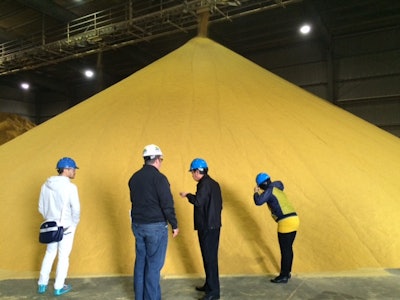
The U.S. Grains Council’s (USGC’s) job is to increase the value of trade for both our members and those who buy our products all around the globe. Since it was founded, the Council has created tailored programs that meet individual countries’ cultures and needs. This also means adapting to changes in our domestic markets, like developing export demand for U.S. coarse grain co-products such as distiller’s dried grains with solubles (DDGS) and ethanol.
The Council has been instrumental in creating a reputation for U.S. DDGS around the world as a staple feed ingredient in livestock rations. The results we have experienced from our U.S. DDGS promotion programs have been incredible: Less than a million metric tons of DDGS, valued at $94 million, were exported in 2004 while more than 11.2 million tons, valued at $2.9 billion, were exported in 2014, an increase of 1,000% in a decade. During that time, DDGS exports went from a minor revenue stream for U.S. ethanol plants to a significant strategic focus.
The proof is in the past
In 2003, the Council identified U.S. DDGS as a co-product that could be successfully included in feed rations globally. We began examining a possible new future for DDGS, starting by identifying target markets based on ease of transportation, potential demand in the livestock sector and existing trade relationships with the United States.
Very early USGC DDGS programs included hosting workshops on contractual terms, documentation and logistical requirements; sending DDGS samples to Asian markets; utilizing animal nutrition consultants to educate feed millers and endusers about the product; and bringing potential buyers to the United States to educate them on the value and utilization of DDGS through seminars and tours of ethanol plants, feed manufacturers and animal feeders.
In the years that followed, the United States rapidly ramped up production of ethanol and, in turn, the availability of ethanol co-products greatly increased. Following this trend and demand from our members, the Council began to invest more time and programming dollars into developing a long-term, reliable export market for U.S. DDGS.
Behind this market expansion were USGC-directed and -implemented educational seminars as well as feeding trials complemented by consistent end-user contact and support. Today, the Council continues to work with its members to address new and developing needs in the DDGS market.
Addressing trade barriers
For example, in 2014 China sought to impose technical barriers to U.S. DDGS imports based on the Chinese government’s lack of approval of the corn biotechnology trait MIR 162. China was and still is the leading export destination for U.S. DDGS, so any disruption in trade there can have a significant market impact. This created new buying opportunities for end users in other importing countries, especially those with whom the Council’s global staff had already been providing consistent trade and technical education to advance corn co-product demand.
While many of these importers took advantage of this market disruption and price advantage, the Council continued its work in China to ease this challenge in coordination with the U.S. Department of Agriculture, U.S. exporters, Chinese importers and the Chinese livestock industry.
Despite a year of turmoil and dramatic market swings, the Council’s efforts helped China remain the top importer of U.S. DDGS in 2014.
The next generation of DDGS
The Council has also helped the U.S. ethanol industry promote DDGS as changes to ethanol production have started removing more oil from the co-product. This process makes the oil available for other uses and also changes the feeding characteristics and potential value of DDGS.
To increase customer and end-user confidence in this low-oil product, the Council has hosted numerous trade teams of overseas customers to visit the United States and provided targeted in-country trade servicing in global markets including Canada, Indonesia, Japan, Korea and Taiwan. Importers and endusers have started to accept low-oil DDGS, and the Council continues to provide these customers with technical information to build demand for the product.
Some of the Council trade teams who focused on low-oil DDGS visited the United States in October 2014 as part of Export Exchange 2014. All in all, this biennial event sponsored by the Council and the Renewable Fuels Association (RFA) brought in 210 international coarse grains buyers from 41 countries to meet with U.S. suppliers and service providers. At the end of the 2014 event, participants reported sales of more than a million metric tons of U.S. DDGS, valued at approximately $200 million.
These past successes and activities have built a foundation for U.S. DDGS in the worldwide market. But there is still more potential for our industry to achieve future sales.
The work continues

In Vietnam, the Council recently launched two independent aqua feeding trials to illustrate that plant-based protein like DDGS is a cost-effective source of protein in fish diets. This fall, when the fish are harvested, an analysis of filet colors will determine what impact the DDGS’ xanthophyll content had on the finished, frozen product — critical to consumer demand. The Council hopes this project will increase Vietnamese buyers’ and end-users’ interest in U.S. DDGS.
The Council has identified southern Mexico as another region with potential to import and use more U.S. DDGS. Last year, the Council conducted a feeding trial supplementing grazing cattle with U.S. DDGS that showed supplemented animals grew twice as quickly as the control group. The Council has been promoting these results and other benefits of using U.S. DDGS to livestock owners in the region since then.
The Council has also undertaken a broad-based effort to educate feed millers and poultry and livestock producers about U.S. DDGS in Saudi Arabia, where the co-product is now included on a subsidy list that heavily influences local buyers. The Council is planning a program in which nutritionists and U.S. merchandisers travel to Saudi Arabia to participate in one-on-one meetings with importers and Saudi nutritionists to provide these critical purchasers with information about the cost savings U.S. DDGS can provide to their rations.
These three projects are just a glimpse into the global strategy the Council is undertaking now and in the years to come to promote U.S. DDGS around the world.
Taking another step: promoting ethanol exports
Though the Council has worked in DDGS promotion for more than a decade, last year we took on another task that deeply affects the grains value chain — ethanol export promotion. In conjunction with Growth Energy, the Renewable Fuels Association (RFA) and the USDA’s Foreign Agricultural Service (FAS), the Council has developed an assessment strategy and is beginning ethanol-specific programming set to ramp up in late 2015 and 2016.
So far, this working group has conducted three market assessment missions that helped us produce an ethanol export promotion strategy and develop country-by-country marketing plans for U.S. ethanol in a handful of near-term markets. It also addresses the work that needs to be done on issues like government mandates, regulations affecting ethanol production and public acceptance. The plan will continue to evolve as market assessments are carried out in places like Canada and the European Union. Among other activities, the Council and its partners are bringing ethanol-focused trade teams to the United States to tour the production chain from U.S. corn farm to export facility.
There is still much work to do as the Council and its partners aim for success in promoting ethanol sales overseas much like our successes promoting DDGS sales overseas.
Member-led and member-focused
The Council’s initiatives supporting DDGS and ethanol exports began because our stakeholders had a pressing need and, in turn, they have benefited tremendously from member engagement. Because of this leadership, the Council remains the only major resource for foreign buyers looking to purchase U.S. DDGS.
USGC members are critical as they provide the support we need to keep these programs evolving to fit the global grain market’s needs. They provide input to our programs during Advisory Team meetings; host trade teams and participate in missions to meet with b
uyers and endusers overseas; and provide constant recommendations and insights for our capacity building and trade servicing programs.
The Council is a proven partner for its members and able to work with and through them toward a common goal of developing and growing global markets. Through member support and input, the Council will continue to use the lessons learned through past successes to capture new export markets around the world. ❚
Editor’s note: U.S. Grains Council is online at www.grains.org. Readers can sign up for the USGC weekly newsletter at https://usgc.informz.net/USGC/profile.asp.

















